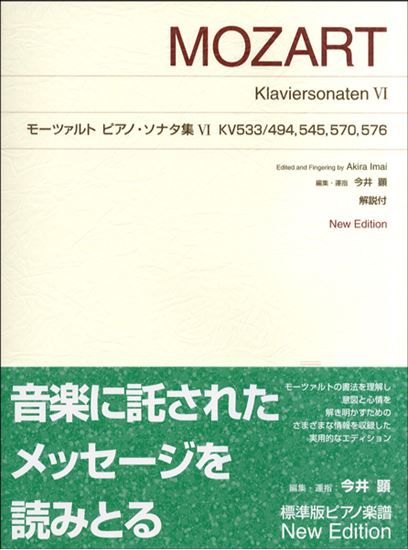Mozart, Wolfgang Amadeus : Sonate für Klavier Nr.18 (Allegro und Andante) Mov.3 Rondeau
Work Overview
Genre:sonata
Total Playing Time:5 min 00 sec
Copyright:Public Domain
Commentary (2)
Author : Ooi, Kazurou
Last Updated: July 21, 2025
[Open]
Author : Ooi, Kazurou
This is the third movement, which features instrumental rather than vocal elements. One can imagine string instruments such as violins playing the theme. From measure 2, detailed articulations are written in the melody line, and these slurs should be followed. For example, the A-G in the first beat of measure 2 has a slur. A is a non-harmonic tone (incidentally, the chord in the first beat of measure 2 is C-E-G-B). Since the next G is the resolution of the non-harmonic tone, give A a slight accent, and for G, quickly lift your finger from the key, playing it softly and short. Similarly, the next G-E should be played in the same way. In measure 4, play the four units in the same manner. These should be thought of as violin bowings.
These articulations mean that notes that should be short will be sustained if the pedal is used. Therefore, while the pedal may be used in measure 1, for measures 2-4, for example, the pedal should be used sparingly, prioritizing the short, detached notes.
There is a hint in the left-hand playing technique. From measures 1 to 4, the C played by the left hand's first finger becomes a pedal point (organ point), meaning that the notes on the downbeat of each beat become the bass notes. In measure 1, these are A and F; in measure 2, B and A; in measure 3, also B and A; and in measure 4, G-E-F-A. Except for measure 4, when playing the left hand in measures 1-3, sustain these bass notes with your finger for the duration of a half note. By doing so, you can maintain the articulations starting from measure 2, play the short notes without excessive pedal, and simultaneously sustain the bass smoothly.
Author : Inada, Saeko
Last Updated: March 1, 2021
[Open]
Author : Inada, Saeko
Allegretto, F major, 2/2 time. Rondo form. Although originally a small-scale rondo, when it was published as a sonata, cadenza-like passages and other elements were inserted, making it suitable as a final movement. Furthermore, contrapuntal treatment was added to achieve unity with the preceding movements.
PTNA & Partner Channel Videos(1items)
Sheet Music
Scores List (7)

(株)全音楽譜出版社

(株)全音楽譜出版社

(株)全音楽譜出版社

(株)音楽之友社

(株)全音楽譜出版社

(株)ヤマハミュージックエンタテインメントホールディングス



